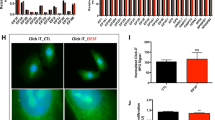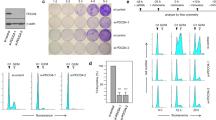Abstract
The eukaryotic initiation factor 3f (eIF3f) is the p47 subunit of the multi-subunit eIF3 complex. eIF3 plays an important role in translation initiation. In the present study, we investigate the biological function of eIF3f in translation and apoptosis in tumor cells. We demonstrated for the first time that eIF3f is downregulated in most human tumors using a cancer profiling array and confirmed by real-time reverse transcription PCR in melanoma and pancreatic cancer. Overexpression of eIF3f inhibits cell proliferation and induces apoptosis in melanoma and pancreatic cancer cells. Silencing of eIF3f protects melanoma cells from apoptosis. We further investigated the biological function of eIF3f. In vitro translation studies indicate that eIF3f is a negative regulator of translation and that the region between amino acids 170 and 248 of eIF3f is required for its translation regulatory function. Ectopic expression of eIF3f inhibits translation and overall cellular protein synthesis. Ribosome profile and ribosomal RNA (rRNA) fragmentation assays revealed that eIF3f reduces ribosomes, which may be associated with rRNA degradation. We propose that eIF3f may play a role in ribosome degradation during apoptosis. These data provide critical insights into the cellular function of eIF3f and in linking translation initiation and apoptosis.
This is a preview of subscription content, access via your institution
Access options
Subscribe to this journal
Receive 50 print issues and online access
$259.00 per year
only $5.18 per issue
Buy this article
- Purchase on Springer Link
- Instant access to full article PDF
Prices may be subject to local taxes which are calculated during checkout












Similar content being viewed by others
Abbreviations
- 7-AAD:
-
7-aminoactinomycin D
- CDK11:
-
cyclin-dependent kinase 11
- C t :
-
threshold cycle
- eIF3:
-
eukaryotic initiation factor 3
- GAPDH:
-
glyceraldehyde-3-phosphate dehydrogenase
- GST:
-
glutathione S-transferase
References
Akiyoshi Y, Clayton J, Phan L, Yamamoto M, Hinnebusch AG, Watanabe Y et al. (2001). J Biol Chem 276: 10056–10062.
Aravind L, Ponting CP . (1998). Protein Sci 7: 1250–1254.
Ariza ME, Broome-Powell M, Lahti JM, Kidd VJ, Nelson MA . (1999). J Biol Chem 274: 28505–28513.
Asano K, Vornlocher HP, Richter-Cook NJ, Merrick WC, Hinnebusch AG, Hershey JW . (1997). J Biol Chem 272: 27042–27052.
Beyaert R, Kidd VJ, Cornelis S, Van de Craen M, Denecker G, Lahti JM et al. (1997). J Biol Chem 272: 11694–11697.
Castelli J, Wood KA, Youle RJ . (1998). Biomed Pharmacother 52: 386–390.
Charalampopoulos I, Tsatsanis C, Dermitzaki E, Alexaki VI, Castanas E, Margioris AN et al. (2004). Proc Natl Acad Sci USA 101: 8209–8214.
Clemens MJ, Bushell M, Morley SJ . (1998). Oncogene 17: 2921–2931.
Dong J, Lai R, Nielsen K, Fekete CA, Qiu H, Hinnebusch AG . (2004). J Biol Chem 279: 42157–42168.
Fraser CS, Lee JY, Mayeur GL, Bushell M, Doudna JA, Hershey JW . (2004). J Biol Chem 279: 8946–8956.
Guo J, Hui DJ, Merrick WC, Sen GC . (2000). EMBO J 19: 6891–6899.
Joseph P, Lei YX, Whong WZ, Ong TM . (2002). Cancer Res 62: 703–707.
King KL, Jewell CM, Bortner CD, Cidlowski JA . (2000). Cell Death Differ 7: 994–1001.
Majumdar R, Bandyopadhyay A, Maitra U . (2003). J Biol Chem 278: 6580–6587.
Martinand C, Salehzada T, Silhol M, Lebleu B, Bisbal C . (1998). Eur J Biochem 254: 248–255.
Mayeur GL, Fraser CS, Peiretti F, Block KL, Hershey JW . (2003). Eur J Biochem 270: 4133–4139.
Meyer LJ, Milburn SC, Hershey JW . (1982). Biochemistry 21: 4206–4212.
Mikolajczyk M, Nelson MA . (2004). Biochem J 384: 461–467.
Miura Y, Thoburn CJ, Bright EC, Chen W, Nakao S, Hess AD . (2002). Blood 100: 2650–2658.
Morley SJ, McKendrick L, Bushell M . (1998). FEBS Lett 438: 41–48.
Nadano D, Sato TA . (2000). J Biol Chem 275: 13967–13973.
Pestova TV, Kolupaeva VG, Lomakin IB, Pilipenko EV, Shatsky IN, Agol VI et al. (2001). Proc Natl Acad Sci USA 98: 7029–7036.
Phan L, Zhang X, Asano K, Anderson J, Vornlocher HP, Greenberg JR et al. (1998). Mol Cell Biol 18: 4935–4946.
Philip T, Guglielmi C, Hagenbeek A, Somers R, Van der Lelie H, Bron D et al. (1995). N Engl J Med 333: 1540–1545.
Sheikh MS, Fornace Jr AJ . (1999). Oncogene 18: 6121–6128.
Shi J, Feng Y, Goulet AC, Vaillancourt RR, Sachs NA, Hershey JW et al. (2003). J Biol Chem 278: 5062–5071.
Shi L, Nishioka WK, Th'ng J, Bradbury EM, Litchfield DW, Greenberg AH . (1994). Science 263: 1143–1145.
Sonenberg N, Hershey JWB, Mathews M (eds) (2000). Translational Control of Gene Expression, 2nd edn. Cold Spring Harbor Laboratory Press: Cold Spring Harbor, NY, pp 33–88.
Tang D, Gururajan R, Kidd VJ . (1998). J Biol Chem 273: 16601–16607.
Thompson FH, Nelson MA, Trent JM, Guan XY, Liu Y, Yang JM et al. (1996). Cancer Genet Cytogenet 87: 55–62.
Wallach D . (1997). Trends Biochem Sci 22: 107–109.
Watkins SJ, Norbury CJ . (2002). Br J Cancer 86: 1023–1027.
Xiang Y, Wang Z, Murakami J, Plummer S, Klein EA, Carpten JD et al. (2003). Cancer Res 63: 6795–6801.
Acknowledgements
We thank the flow cytometry core at the University of Arizona for the apoptosis assay. We also thank the GI SPORE tissue core (Katie Benson, John Cunningham and Achyut Bhattacharyya) for providing us the pancreatic cancer tissues. We thank Roy Parker for critical discussions. This work was supported by Cancer Biology Training Grant CA 09213 from the National Institute of Health, Faculty Small Grant Program (University of Arizona), ABRC grant (5-102), Grants CA70145 (MN) and GM22135 (JH) and Center Grants ES066694 and GI SPORE CA95060.
Author information
Authors and Affiliations
Corresponding author
Rights and permissions
About this article
Cite this article
Shi, J., Kahle, A., Hershey, J. et al. Decreased expression of eukaryotic initiation factor 3f deregulates translation and apoptosis in tumor cells. Oncogene 25, 4923–4936 (2006). https://doi.org/10.1038/sj.onc.1209495
Received:
Revised:
Accepted:
Published:
Issue Date:
DOI: https://doi.org/10.1038/sj.onc.1209495
Keywords
This article is cited by
-
N6-Methyladenosine Methylation of mRNA in Cell Apoptosis
Molecular Neurobiology (2023)
-
Characterization of a type III polyketide synthase (sjPKS1) gene and its expression in response to light in the economic brown alga Saccharina japonica
Journal of Applied Phycology (2022)
-
Eukaryotic translation initiation factors as promising targets in cancer therapy
Cell Communication and Signaling (2020)
-
Nuclear control of lung cancer cells migration, invasion and bioenergetics by eukaryotic translation initiation factor 3F
Oncogene (2020)
-
A cyclin-dependent kinase, CDK11/p58, represses cap-dependent translation during mitosis
Cellular and Molecular Life Sciences (2020)



